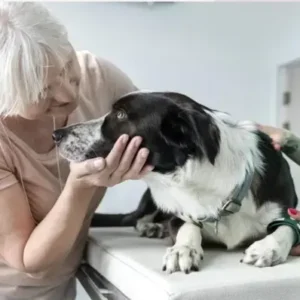Common Causes of Hypothyroidism
The development of hypothyroidism in dogs is often linked to specific underlying issues that interfere with the thyroid gland’s ability to function properly. Understanding these causes can help dog owners identify risks and seek appropriate veterinary care.
- Autoimmune Thyroiditis (Immune-mediated destruction of the thyroid gland): The dog’s immune system mistakenly attacks the thyroid tissue.
- Idiopathic Atrophy of Thyroid Gland: The thyroid tissue degenerates over time for unknown reasons, potentially leading to hormonal imbalances.
- Lymphocytic Thyroiditis: Inflammation of the thyroid gland caused by the dog’s immune system mistakenly attacking thyroid tissue.
- Other Rare Causes: Tumors, congenital hypothyroidism (which is already present at birth), or injury to the thyroid gland.
Signs and Symptoms of Hypothyroidism in Dogs
Hypothyroidism often develops slowly, which makes it easy to overlook in its early stages.
Common symptoms of hypothyroidism include:
Physical Symptoms
Recognizing physical symptoms early can help in identifying hypothyroidism before it worsens.
- Weight Gain: Dogs gain weight despite no change in diet or exercise.
- Lethargy: Reduced energy levels and an overall lack of enthusiasm.
- Dry, Flaky Skin: The coat becomes dull and brittle.
- Ear Infection: Frequent infections may signal hypothyroidism.
- Hair Loss: Symmetrical hair loss, particularly on the tail and flanks.
- Cold Intolerance: Dogs seek warmth or shiver in mild temperatures.
- Slow Heart Rate: Reduced heart rate, often detected during a vet checkup.
Behavioral Changes
Behavioral changes may be subtle but are important clues that your dog might be suffering from hypothyroidism.
- Mental Dullness: Dogs may appear sluggish or less alert.
- Exercise Intolerance: Dogs tire quickly during physical activity.
- Depression-like Symptoms: A noticeable lack of interest in play or interaction.
Other Symptoms (Less Common)
Though less common, these symptoms can still indicate underlying thyroid issues and shouldn’t be ignored.
- Nerve dysfunction (e.g., facial paralysis)
- Reproductive issues in unspayed or unneutered dogs
- High cholesterol levels detected in blood tests
If you observe any combination of these symptoms, a veterinary consultation is essential for proper diagnosis.
Breeds at Risk of Hypothyroidism
While hypothyroidism can affect any dog breed, certain breeds are predisposed to this condition:
- Golden Retriever
- Labrador Retriever
- Doberman Pinscher
- Boxer
- Irish Setter
- Cocker Spaniel
Most dogs diagnosed with hypothyroidism are middle aged dogs (4-10 years old), and the condition occurs more frequently in medium to large breeds. Interestingly, hybrid dog breeds tend to be less prone to such health issues. This is because genetic diversity often reduces the risk of inherited conditions.
Diagnosis of Hypothyroidism in Dogs
Veterinarians use a combination of clinical signs, physical examination of your dog, and blood tests to diagnose hypothyroidism.
- Physical Examination: Identifying symptoms such as weight gain, lethargy, and coat changes.
- Total T4 Test: Measures overall thyroid hormone levels.
- Free T4 by Equilibrium Dialysis: Provides a more accurate reading of available thyroid hormones.
- Thyroid Stimulating Hormone (TSH): Elevated TSH indicates the thyroid gland is underperforming.
- Rule Out Other Conditions: Other disorders, like Cushing’s disease or obesity, can mimic hypothyroid symptoms.
A proper diagnosis ensures your dog receives the appropriate treatment.
Treatment of Hypothyroidism in Dogs
Hypothyroidism in dogs is treated with lifelong thyroid hormone replacement therapy. With regular administration of this medication and periodic checkups, this can be well-managed, allowing them to lead happy and active lives.
Levothyroxine (Synthetic T4)
These tests are important for managing cases of hypothyroidism in dogs.
- This oral medication replaces the missing hormone with synthetic thyroid hormone.
- The dosage is tailored to the dog’s weight and condition.
- Improvements, such as increased energy and improved coat quality, are often seen within a few weeks.
Ongoing Monitoring
Regular follow-up visits and blood tests are essential to:
- Monitor your dog’s hormone levels
- Adjust the medication dosage if needed
- Ensure the treatment is working effectively
Managing Your Dog’s Life with Hypothyroidism
With proper treatment, dogs with hypothyroidism can lead healthy, happy lives. Here are some tips to support your dog:
- Diet and Weight Management: Feed a balanced, high-quality diet to maintain a healthy weight.
- Exercise: Regular but moderate activity helps combat weight gain and improves overall health.
- Monitor Symptoms: Watch for any changes in energy levels, coat quality, or appetite.
- Routine Vet Visits: Regular checkups ensure thyroid hormone levels remain stable.
Can Hypothyroidism Be Prevented?
While there is no guaranteed way to prevent hypothyroidism, you can take steps to ensure early detection and overall thyroid health:
- Schedule regular veterinary checkups, especially for at-risk breeds.
- Avoid breeding dogs with a history of hypothyroidism.
- Provide a nutritious diet rich in essential vitamins and minerals.








